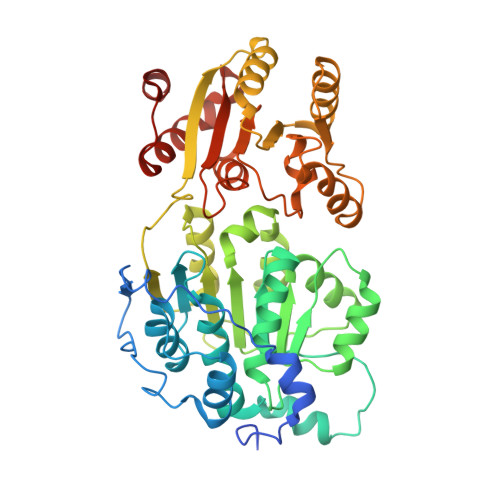Cancer-Associated Mutants of RNA Helicase DDX3X Are Defective in RNA-Stimulated ATP Hydrolysis.
Epling, L.B., Grace, C.R., Lowe, B.R., Partridge, J.F., Enemark, E.J.(2015) J Mol Biology 427: 1779-1796
- PubMed: 25724843
- DOI: https://doi.org/10.1016/j.jmb.2015.02.015
- Primary Citation of Related Structures:
4PX9, 4PXA - PubMed Abstract:
The DEAD-box RNA helicase DDX3X is frequently mutated in pediatric medulloblastoma. We dissect how these mutants affect DDX3X function with structural, biochemical, and genetic experiments. We identify an N-terminal extension ("ATP-binding loop", ABL) that is critical for the stimulation of ATP hydrolysis by RNA. We present crystal structures suggesting that the ABL interacts dynamically with ATP and confirming that the interaction occurs in solution by NMR chemical shift perturbation and isothermal titration calorimetry. DEAD-box helicases require interaction between two conserved RecA-like helicase domains, D1 and D2 for function. We use NMR chemical shift perturbation to show that DDX3X interacts specifically with double-stranded RNA through its D1 domain, with contact mediated by residues G302 and G325. Mutants of these residues, G302V and G325E, are associated with pediatric medulloblastoma. These mutants are defective in RNA-stimulated ATP hydrolysis. We show that DDX3X complements the growth defect in a ded1 temperature-sensitive strain of Schizosaccharomyces pombe, but the cancer-associated mutants G302V and G325E do not complement and exhibit protein expression defects. Taken together, our results suggest that impaired translation of important mRNA targets by mutant DDX3X represents a key step in the development of medulloblastoma.
- Department of Structural Biology, St Jude Children's Research Hospital, 262 Danny Thomas Place, Mail Stop 311, Memphis, TN 38105, USA.
Organizational Affiliation:


















